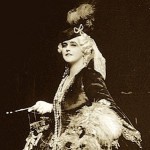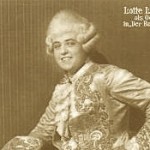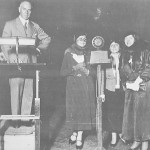You may want to read about early recordings to put this famous one of Lehmann’s Der Rosenkavalier 1933 recording, in perspective. It’s also fascinating to read what Lehmann herself had to say about the opera. There are many references to LL’s performances as the Marschallin in magazine articles. Here are a few samples from the famous studio recording of the opera: Da geht er hin, der aufgeblasene schlechte Kerl and Hab’ mir’s gelobt. Below you may read reviews of the live Met Rosenkavalier of 1939.
 Lehmann fans are well-aware that she created the definitive realization of the role of the Marschallin in Der Rosenkavalier of Richard Strauss.
Lehmann fans are well-aware that she created the definitive realization of the role of the Marschallin in Der Rosenkavalier of Richard Strauss.
Most followers of her career also know that she was the first to sing all three leading soprano roles in the opera. Norman Del Mar in his detailed book on Strauss writes: “…of all the great artists who have made their reputations in this most endearing and human of all operas it is surely Lotte Lehmann who has reached the greatest heights and won the most hearts with her creation of the great lady.” Although Lehmann was associated world-wide with this role, she reminded interviewers (me among them) of her devotion to singing Fidelio, her love for the role of Elisabeth in Tannhäuser or the humanity she found in Sieglinde in Die Walküre. But she did have a fascination with the character of the Marschallin and its detailed realization in sound and action. Sadly we have only audio records of her Marschallin performances. These are of high quality and I only say “sadly” because of the consistent high praise she received for her acting. “She was every inch a princess–voice and gesture alike…” (Telegraph); “…an actress whose quiet ease is the perfection of the art that conceals art” (Ernest Newman); “…nobility of style and a depth and variety of emotion,” (unidentified source).
have only audio records of her Marschallin performances. These are of high quality and I only say “sadly” because of the consistent high praise she received for her acting. “She was every inch a princess–voice and gesture alike…” (Telegraph); “…an actress whose quiet ease is the perfection of the art that conceals art” (Ernest Newman); “…nobility of style and a depth and variety of emotion,” (unidentified source).
When the “ideal” cast was gathered to record the opera in 1933, the result was critical as well as public approval. The original 78rpm album was available until the 1953 re-issue on microgroove (both 45 and 33rpm), followed by a long list of further reissues, re-mastering, cassette and CD formats. A “direct from metal masters” CD from Références is available, a fine release from Naxos and most recently, the Pristine version, with their own acoustically enhanced process. The CD released by Pearl made from shellacs isn’t as good as LPs. During the past decades critics have consistently referred to the recording as the “classic Rosenkavalier” (David Hall); “precious heritage” and “impersonations that will be remembered as long as the opera is played” (Irving Kolodin).
The following article is by Horst Wahl. Not only was he familiar with all aspects of recordings of that time, but he was also a personal friend of Mme. Lehmann. His dedication to Lehmann is evident in the care he has taken.
[There are discographical errors in his table, which are corrected in the complete discography]
DER ROSENKAVALIER: The Classic Recording by Horst Wahl
If ever in the history of opera there were an identification between a role and an artist it would be that of Lotte Lehmann as the Marschallin in Richard Strauss’ Der Rosenkavalier. It was a lucky strike that both this role and that of Sieglinde in Die Walküre were recorded in Lehmann’s prime. In 1932 it had been decided to produce the complete Der Rosenkavalier with the composer as conductor. But his price as well as that of Bruno Walter led to the selection of Walter’s protogée Robert Heger.
The effects of the Depression were not yet over, so cost cutting measures had to be considered. This included the “cuts” made in this long opera. 12 discs were originally projected, but finally 13 were released (26 sides) in which the choices allowed for connecting scenes of the high points of the opera.
Lehmann was the obvious choice for the Marschallin; Elisabeth Schumann as Sophie and Richard Mayr as Baron Ochs were almost as inevitable. In the happy choice of Maria Olszewska as Octavian, HMV found an aristocratic sounding mezzo whose sound was sufficiently different from that of Lehmann and Schumann, but who provided a complete blending in the duets and trios.
The recording was to take place in Vienna, thus the inclusion of the Vienna Philharmonic and Vienna State Opera Chorus. It was financially feasible to record in the “Mittlere Saal” [Middle Hall], although the 1935 recording of Die Walküre demonstrates the acoustic superiority of the large “Musikvereins-Saal.”
The orchestra consisted of 10 first and 8 second violins; 6 violas, 5 ‘cellos, 5 basses, 1 piccolo, 2 flutes, 3 clarinets, English horn, 3 bassoons, 4 horns, 3 trumpets, 2 trombones, 2 bass trombones, 1 tuba, 2 harps, tympani, drums, celeste and piano.
Members of the chorus of the Vienna State Opera and the Vienna Philharmonic Orchestra were conducted by Robert Heger.
The dates, matrix and take numbers are valid only for published takes. Because there were two cutting machines working at the same time during the recording sessions, each take produced two wax masters. The recordings of the first machine were unidentified in the matrix numbers; those of the second machine are shown by an “A” after the take. Catalog numbers DB 2060 – 72 (matrix 2WX 581 – 606) were issued in England in December 1933 and in Germany in June 1934. They were issued in America on Victor 7917 – 29 (set M – 196) which included matrix numbers CVS 81418 – 81443. The auto coupling set was AM – 196 (7930 – 42), auto drop sequence coupling DM – 196 (17119 – 31).
The following list [not included: see complete discography] demonstrates what an incredible confusion existed in the order of the recordings. Our wonder and appreciation for the highest artistic standards are awakened when one hears the development and connection that is achieved. If one imagines listening to the four minute “takes” that we hear unbroken on LP or CD, then one has a better appreciation for the level of identification the artists had with their roles and the situations.
The recordings began on the afternoon of 20 September 1933 and ended 4 1/2 days later.
The great number of “takes” doesn’t necessarily indicate artistic errors; the necessary combinations of solo and ensemble voices with orchestra demanded by the score forced the technicians to try various microphone placements [Remember only one microphone was used]. Both cutting machines produced the same number of possibly usable waxes, but far from all were saved and registered. Technical and musical reasons resulted in the destruction of many. A total of 58 “takes” or 95 wax recordings, of which 2 were damaged during the trip to England, were quickly made into the album in time for Christmas sales.
Though it was disappointing that the “singer’s aria” was missing, nevertheless there was world-wide acclaim for the recording. Many enjoyed Beniamino Gigli in the role of the Italian singer, but his fee would have been too high. Later a German recording with Helge Rosvaenge was welcomed. [At this point Horst Wahl recounts the story, told to him by Mme. Lehmann and later recounted by her in various interviews, of how she missed singing the famous “Ja, Ja” at the end of the opera. Herr Wahl provides the precise historic data to document the evident confusion that recording such a huge work in four minute scraps must have caused. In the end Schumann sang the words produced on the recording, although Lehmann also recorded them. It was because of Heger’s decision of what length music should appear on the last disc, that Lehmann’s “take” wasn’t used.]
Alan Blyth writes in the Gramophone; May 1999; Richard Strauss: Der Rosenkavalier; Naxos Historical 8 110034/6; 3 discs; 168 minutes.
Recorded from a broadcast performance at the Metropolitan, NY on 7 Jan ’39; Songs recorded from a broadcast performance in the Hollywood Bowl, LA, 5 Aug ’48: Strauss: Zueignung, Allerseelen, Traum durch die Dämmerung, Morgen; Brahms: Wiegenlied; Schubert: Ständchen.
You may wonder why there’s room, on the third disc of the recording of Der Rosenkavalier, for 6 songs from LL. The reason lies in the Bodanzky’s heinously arbitrary cuts then customary at the Metropolitan. Yet this issue is an essential document in that it allows us to hear Lehmann’s Marschallin live at a point in her career when she was able, at 51, still to give the lovable, warm, instinctive reading of the role familiar from the 1933 EMI excerpts, available on several reissues (Pearl, 3/90 and EMI References, 4/93). Every phrase reveals her interpretive insights and her inborn spontaneity of response, and shows her to be a complete mistress of Strauss’ conversational style, not least in her unsentimental, elegiac account of the Monologue–and how this Marschallin knows what she is talking about when she tells Octavian of Time’s demands. The voice remains heart-warming as ever, as it does in the uniquely outgoing way she sings her Strauss Lieder with Ormandy—time seems to stand still as she sings, so movingly, Traum durch die Dämmerung and Morgen. The tone of the 60 year old soprano seems practically untouched by time or wear; only the Schubert and Brahms items betray some frailty.
In the opera, Risë Stevens in her debut as Octavian, is impetuous enough, but unconvincing as Mariand’l, Marita Farell, a silver voiced Sophie, Schorr—no less—a secure Faninal, but List is a self-indulgent, uninteresting Ochs. Bodanzky conducts a fast, vital amount of what remains of the score. The not-so-good recording often distorts the higher voices, but Lehmann enthusiasts won’t mind all that; rather they will savor the bench-mark Marschallin. At the price it’s well worth acquiring this historic document.
Naxos Rosenkavalier; Michael Oliver, International Opera Collector, Spring 1999
“Two recent releases in Naxos’s ‘Immortal Performances’ series will have many collectors agog with expectation. A performance of Strauss’s Rosenkavalier, recorded at the New York Met in January 1939, is of capital interest as the only ‘complete’ record of Lotte Lehmann’s portrayal of the Marschallin, ‘complete’ in quotation marks because the opera is so savagely cut (roughly 20 minutes from each act) that there is room for a brief, very late but touching song recital by Lehmann on the third CD. In the opera a few signs of vocal unease betray the fact that this is a lady in her fifties, but no less unmistakably that she is a very great lady indeed: she silences the audience with her noble launching of the Act 3 Trio and her aristocratic grace is everywhere apparent…. The recorded sound is screamingly harsh at times, Artur Bodanzky’s orchestra often hideously distorted. (8.110034/6)”
Leicht muss man sein; Hugh Canning. International Opera Collector; Spring 1999.
The author examines various performances of the role of the Marshallin in Der Rosenkavalier by Strauss. Of course he mentions Lehmann.
“The most famous of pre-war Marshallins was unquestionably Lehmann, one of the great Elsas and Sieglindes of her day, who created the lyric soprano role of the Composer in the Vienna premiere of Aridane II and the dramatic soprano role of the Dyer’s Wife in Die Frau ohne Schatten. Lehmann’s voice must have developed gradually into the heavier parts, for she is the first of several celebrated Rosenkavalier ‘hat-trick’ holders: sopranos who have progressed from Sophie to Octavian to the Marshallin….
Lehmann’s Marscahllin was, of course, the first to be captured substantially by the gramophone and the ‘abridged’ HMV recording of Der Rosenkavalier, conducted by Robert Heger and with its famous constellation of co-stars–Maria Olszewska as Octavian, Elisabeth Schumann as Sophie, the ripely characterful and sonorous Richard Mayr as Ochs—has accorded her interpretation an almost iconic status, at least among sopranos who sang the role during the composer’s lifetime.
The recording remains an important document, not least because Lehmann was clearly one of the sopranos who served as inspirational muse to Strauss: in addition to the Composer and Dyer’s Wife, she was also entrusted with the creation of one of his most individual and beloved protagonists, Christine Storch in Intermezzo, a thinly disguised portrait of Strauss’s wife Pauline. [One shouldn’t forget that his Arabella was written with LL in mind]
By 1933, when the HMV recordings were made, Lehmann was already 45 …as was, more astonishingly yet, her exact contemporary Elisabeth Schumann, who sang Sophie–and the voice, an instrument of burnished old gold, was beginning to show its age: the bottom register, in particular, sounds chesty and robust, lending Lehmann’s Marie-Therese a matronly quality which I personally find hard to take today. It’s hard to tell whether the limitations of the recording process or the passage of time are principally responsible for the hardening of Lehmann’s vocal sinews, but there remain phrases which she sings with a tonal refulgence and easy delivery which few Marshallins of the modern era have matched: her expansive singing of her instruction to her little black page, Mohamed, ‘Da drin ist die silberne Ros’n’, still has the power to thrill the ear.
And Lehmann’s dramatic conception of the role manages to convince despite her age: she is coquettish with both Octavian and Ochs, using a sly portamento (‘Du, Schatz!’) to convey her amusement at the Mariandel disguise, and she seems more tolerant than most of her successors of her ‘aufgeblasene, schlechte Kerl’ of a cousin. Indeed, from the histrionic point of view, Lehmann maintains the melancholic and frivoluous sides of the Marschallin’s personality in carefully balanced equilibrium: the dry eye much in evidence in her teasing of her lover and remonstrations with Ochs, the wet one in her nostalgic reminiscences of ‘die kleine Resi’ fresh from the convent in the Act 1 monologue and especially in the ‘Heut’ oder morgen’ section the the succeeding duet with Octavian. Long experience of the opera has evidently led to a deep understanding of the Marshallin’s mercurial temperament: her tears are not self-pitying ones and they do not for long dull the twinkle in her eye…
Two recordings of the Met broadcasts of Der Rosenkavalier exist–the score heavily cut, though less so than the HMV studio version–preserving Lehmann’s Marschallin of the late 1930’s, by which time she was in her fifties. I have not yet heard the taping Naxos is about to release, [see above] but the performance of February 5th, 1938, conducted by Artur Bodanzky is available on Lys (326 – 327). As in many live recordings of this period, it is not always possible to discern the nuances of the singers’ interpretations. By comparison, the HMV set is revelatory, but it is interesting to hear one of the great Hans Sachses and Wotans of the day, Friedrich Schorr, lavishing his substantial Heldenbariton on the old fusspot Faninal…”

